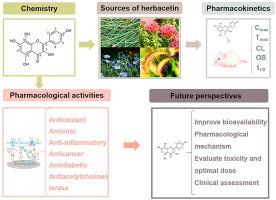Journal of Ethnopharmacology ( IF 4.8 ) Pub Date : 2021-06-21 , DOI: 10.1016/j.jep.2021.114356 Xiaohan Wei 1 , Zhejun Zhao 2 , Rongheng Zhong 2 , Xiaomei Tan 1

|
Ethnopharmacological relevance
Herbacetin is an active constituent of traditional Chinese medicines such as Ephedra sinica Stapf (MaHuang) and Sedum roseum (L.). Scop. (Hong JingTian). MaHuang was used to treat cough, asthma, fever, and edema for more than 5000 years, while Hong JingTian was used to treat depression, fatigue, cancers, and cardiovascular disease. Recent studies indicate that herbacetin and its glycosides play a critical role in the pharmacological activities of these herbs. However, currently, no comprehensive review on herbacetin has been published yet.
Aim of the study
This review aimed to summarize information on the chemistry, natural sources, and pharmacokinetic features of herbacetin, with an emphasis on its pharmacological activities and possible mechanisms of action.
Materials and methods
A literature search was performed on the Web of Science, PubMed, and China Knowledge Resource Integrated databases (CNKI) using the search term “herbacetin” (“all fields”) from 1935 to 2020. Information was also obtained from classic books of Chinese herbal medicine, Chinese pharmacopeia, and the database “The Plant List” (www.theplantlist.org). Studies have been analyzed and summarized in this review if they dealt with chemistry, taxonomy, pharmacokinetic, and pharmacological activity.
Results
Herbacetin is distributed in various plants and can be extracted or synthesized. It showed diverse pharmacological activities including antioxidant, antiviral, anti-inflammatory, anticancer, antidiabetic, and anticholinesterase. It is thought to have great potential in cancer treatment, especially colon and skin cancers. However, the bioavailability of herbacetin is low and the toxicity of herbacetin has not been studied. Thus, more studies are required to solve these problems.
Conclusions
Herbacetin shows promising pharmacological activities against multiple diseases. Future research should focus on improving bioavailability, further studying its pharmacological mechanism, evaluating its toxicity and optimal dose, and performing the clinical assessment. We hope that the present review will serve as a guideline for future research on herbacetin.































 京公网安备 11010802027423号
京公网安备 11010802027423号